8 Low-Maintenance Landscaping Ideas for New England
BY JEFFERY KEUSSEYAN | MAY 25TH, 2023 | LAWN CARE, NEW ENGLANDLove for the outdoors is a common trait among most New Englanders. But after a tiresome hike along the trails of Mount Washington, you may wish to spend some time relaxing in your own backyard. But then you remember that your grass needs mowing, or your annuals have died out and need replacement. With 8 low-maintenance landscaping ideas for New England, you won’t have to worry about any back-breaking or time-consuming chores.
In this article:
- Plant Perennials for Long-Lasting Charm
- Support the Environment with Native Plants
- Mulch Your Garden Beds
- Add Sustainable Hardscape Features
- Xeriscape to Conserve Water
- Plant Low-Maintenance Groundcovers
- Consider Eco-Friendly Artificial Grass
- Install an Automatic Irrigation System
1. Plant Perennials for Long-Lasting Charm
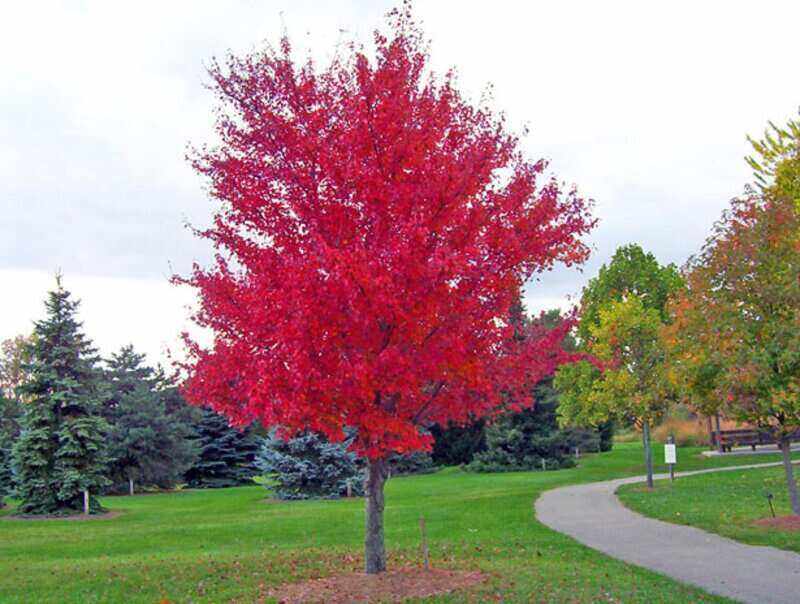
Photo Credit: Public Domain Pictures
To go year after year without having to add new plants, use perennials. Unlike annuals, they last for more than 2 years and come back on their own after dormancy. Perennials native to the region will thrive with little to no maintenance, as they are well-adapted to the local climate. Just as they benefit the local wildlife habitat, perennials such as deciduous trees will adorn your landscape for years to come.
Here are some everlasting perennials for your low-maintenance landscape:
- Gray dogwood (Cornus racemosa)
- Rhododendron
- Red maple (Acer rubrum)
- American hornbeam (carpinus caroliniana)
Advantages of perennials:
- Save you the hassle of having to replant every year
- Grow deep roots that improve the soil’s structure
- Provide shade to the soil and keep it moist
- Time-saving
- Serve as shelter and valuable food source for various bird species
Estimated cost: The cost of perennials depends on the plant’s size, and type. On average, a perennial plant will cost you between $10 and $100.
2. Support the Environment with Native Plants
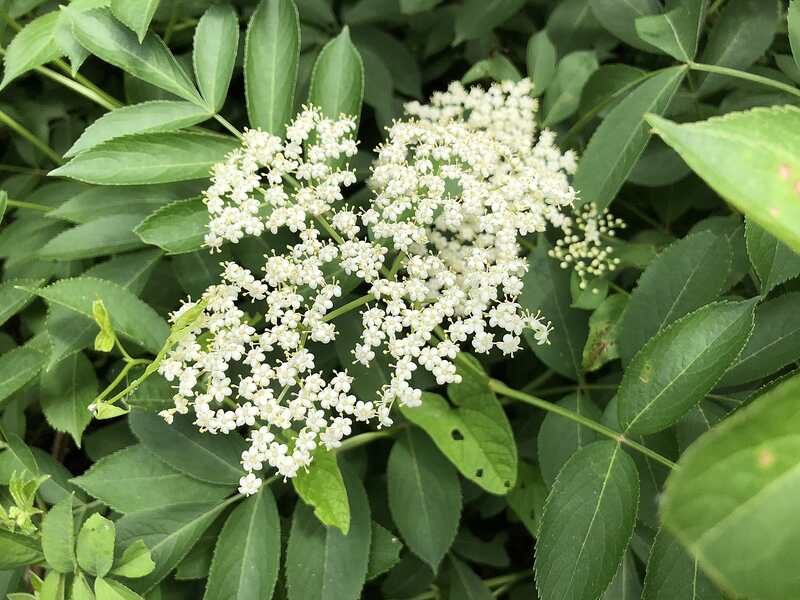
Photo Credit: Famartin / Wikimedia Commons / CC BY-SA 4.0
Wherever you’re based in New England, you will eventually come across native plants that grow naturally in your area. For that reason, you won’t have to worry about regular watering or fertilizing. Native plants can attract beneficial insects to your back or front yard, and provide a valuable source of food for butterflies, hummingbirds, and other pollinators.
Be sure to consider your area’s hardiness zone, the plant’s need for full sun, and growth potential before establishing a native garden.
We suggest the following native plants for your garden design:
- Black-eyed susan (Rudbeckia hirta)
- Goldmoss stonecrop (Sedum acre)
- American black elderberry (Sambucus nigra)
- Ground nut (Apios americana)
Advantages of native plants:
- Less watering; saves time and money
- Little to no chemical treatments
- Less prone to pests and disease
- Help preserve local ecosystem
- Easy to grow
Estimated cost: Depending on the plant’s type and size, expect to pay between $600 and $3,000 per flower bed, $25 and $50 per shrub, $150 and $3,000 per tree.
3. Mulch Your Garden Beds
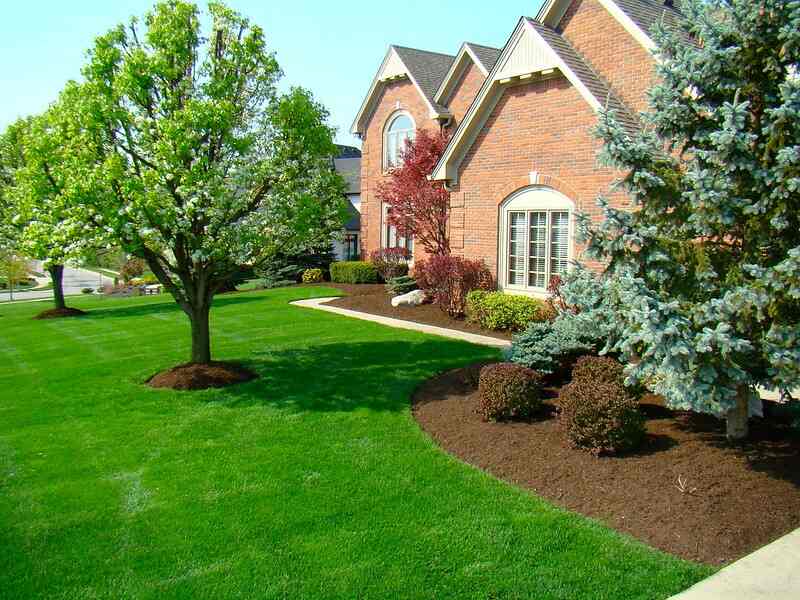
Photo Credit: Tom Britt / Flickr / CC BY 2.0
Mulch is a simple yet effective way to obtain a low-maintenance landscape. It smothers weeds before they grow, retains moisture in the soil, and helps make the garden bed look more attractive. Inorganic mulch will make flower beds more aesthetically pleasing, while organic mulch will offer more nutritional benefits to enhance growth. There is no right or wrong option, just your personal preference and landscape design.
Organic mulch:
- No synthetic materials
- Suppresses weeds
- Adds beneficial nutrients to your garden
- Examples include needles, grass clippings, shredded leaves, bark, and pine
Inorganic mulch:
- No added nutrients to the soil
- Fully blocks weeds
- No plant-based materials
- Examples include gravel, stone, and landscape fabric
Advantages of mulch include:
- Adds nutrients to the soil (if organic)
- Protects soil and roots from harsh weather conditions
- Controls the germination and growth of weeds
- Improves soil drainage and structure
- Saves money on fertilizers (prevents vitamin loss in plants)
Estimated cost: On average, mulch will cost you between $45 and $130, depending on which type of mulch you choose.
4. Add Sustainable Hardscape Features
Hardscaping is integrating non-living, hardy elements in your landscape design. They are features that provide shape and functionality to your outdoor living space. The best part is that you can remove watering, pruning, and fertilizing from your to-do list. Hardscaping will help make your outdoor landscape more enjoyable, and reduce the amount of hours spent on maintenance work.
Some examples of hardscapes include:
- Walkways
- Outdoor kitchen
- Gazebos
- Pergolas
- Vertical gardens
- Retaining walls
- Fire pits
Advantages of hardscaping:
- Improve your property’s functionality
- Conserve water by reducing supplemental irrigation
- Limit the growth of weeds
- Enhance drainage and reduce erosion
- Add value and curb appeal to your home
- Can serve recreational purposes
Estimated cost: There are several features to choose from, each at a different cost. Expect to pay between $3,600 and $9,500 for retaining walls, $2,100 and $6,000 for a pergola, $5,365 and $9,025 for a gazebo, $370 and $2,235 for a fire pit.
5. Xeriscape to Conserve Water
One of the best low-maintenance ideas, xeriscaping helps reduce or eliminate the need for irrigation. From drought-tolerant plants to rock gardens, xeriscaping helps you create a beautiful and cost-effective backyard. Such features are wildlife friendly, and can provide shelter to beneficial insects and pollinators. Overall, a xeriscaped landscape needs little or no water beyond what nature provides.
Here are some water-saving examples of xeriscaping:
- Shade trees
- Adding local rocks or boulders
- Drought-tolerant plants
- Hardy succulents, such as sempervivum species
- Rain or cottage gardens
- Rainwater recycling systems
Advantages of xeriscaping:
- Less mowing, weeding, and watering
- Promotes biodiversity
- Creates an inviting outdoor space
- Reduces water bill
- Attracts future buyers
Estimated cost: The average cost of xeriscaping ranges from $5 to $20 per square foot.
6. Plant Low-Maintenance Groundcovers
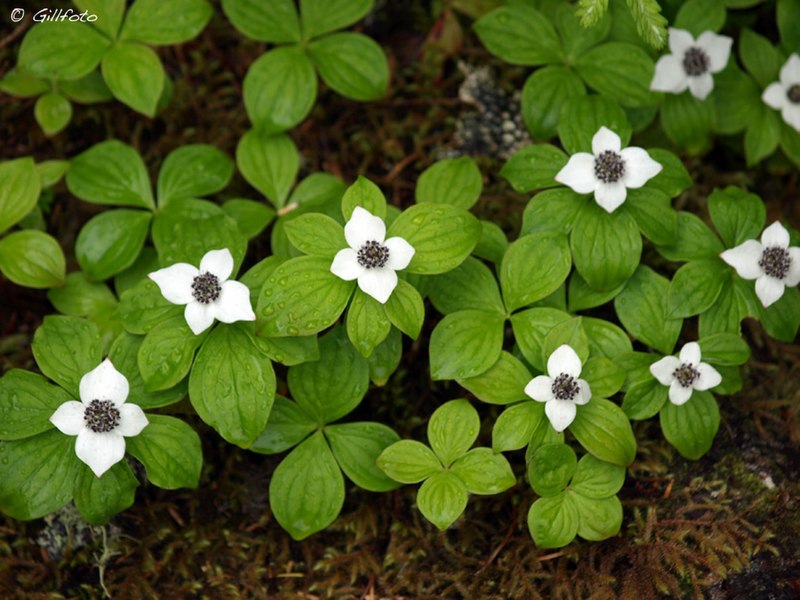
Photo Credit: Gillfoto from Juneau, Alaska, United States / Wikimedia Commons / CC BY-SA 2.0
By planting groundcovers, you will cut back on chores, such as mowing or aerating your lawn. They are low-growing plants with lower maintenance requirements than traditional turfgrass. Groundcovers can help prevent erosion and retain moisture in the soil. You can go for aesthetically pleasing groundcovers that add plenty of color to your yard, or the plain green ones for a more traditional look.
Here are some suitable groundcovers for your New England landscape:
- Common periwinkle (Vinca minor)
- Germander (Teucrium)
- Bunchberry dogwood (Cornus canadensis)
- Spotted henbit (Lamium maculatum)
- Interrupted fern (Osmunda claytoniana)
Advantages of groundcovers:
- Require lower maintenance than traditional turfgrass
- Attract beneficial insects
- Reduce the use of chemical herbicides
- Improve your landscape’s aesthetic appeal
Estimated cost: Depending on which type you choose, a groundcover will typically cost you between $4 and $40.
7. Consider Eco-Friendly Artificial Grass
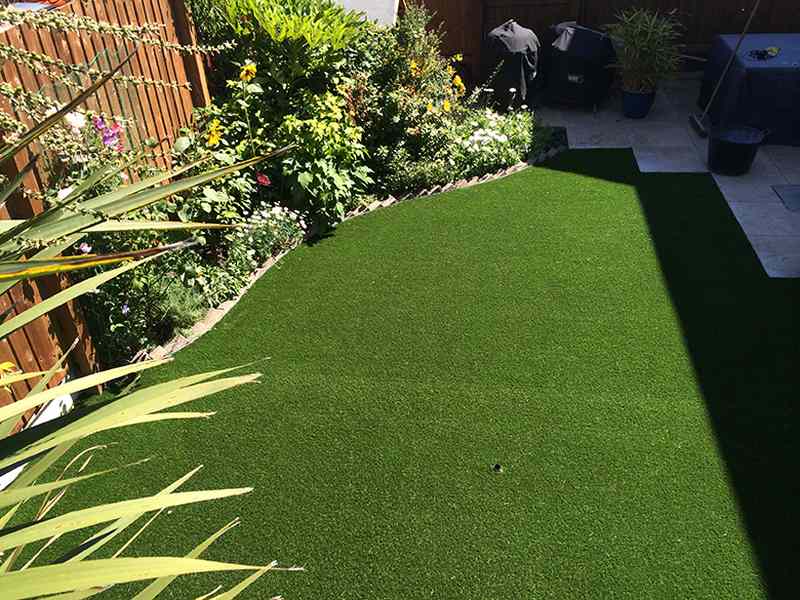
Photo Credit: R3dus-01 / Wikimedia Commons / CC BY-SA 4.0
Artificial grass may look so life-like that your jealous and envious neighbors won’t be able to tell the difference! Replacing traditional grass with synthetic turf will provide you with a year-round green lawn. It helps you reduce the need for fertilizers and pesticides, making it an eco-friendly alternative. Artificial grass can also withstand heavy foot traffic, justifying its increased popularity as a low-maintenance landscaping option.
Advantages of artificial grass:
- Water-efficient
- No need for regular mowing, watering, or fertilizing
- No need to hire a landscaping company for upkeep
- Can withstand harsh weather conditions
- Reduces the need for chemical fertilizers and pesticides
- Long-lasting solution
Estimated cost: The cost of getting artificial turf professionally installed ranges from $5 to $20 per square foot on average.
8. Install an Automatic Irrigation System
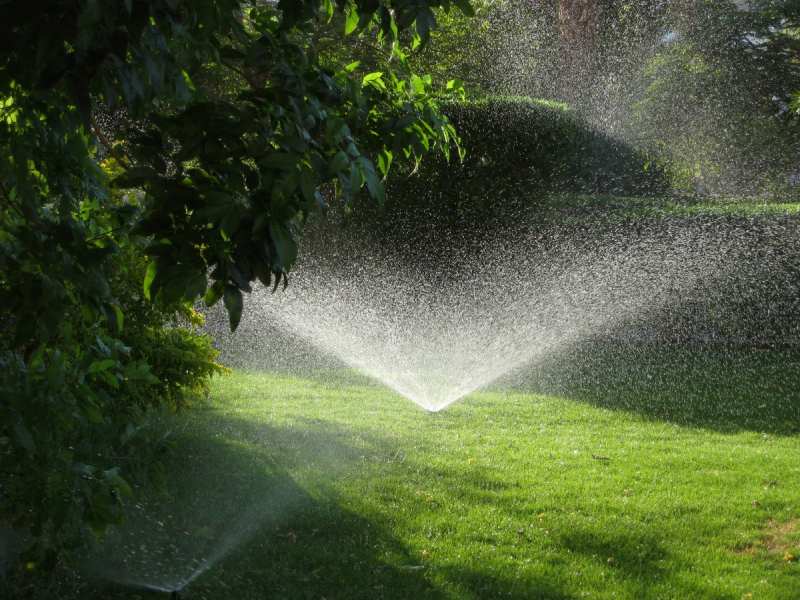
Photo Credit: PxHere
This is a great way to save both time and money. This type of irrigation system can be programmed to automatically water your yard with a specific amount of water, ensuring an even distribution. The system is quite easy to adjust, you only need to set the timer and duration. With this type of technology, you can maintain a healthy lawn without manually watering the plants or grass yourself.
Advantages of an automatic irrigation system:
- Easy-to-adjust system
- Save time and reduce water bill
- Ensures even distribution of water where levels are low
Estimated cost: Hiring a landscape architect to install an irrigation system will cost you between $2,000 and $4,900, depending on your yard size and the system you choose.
FAQ About Low-Maintenance New England Landscaping
Given the Northeast’s climate, cool-season grasses are most suited for your New England landscape. However, some cool-season grasses are high-maintenance, and do not make the homeowner’s to-do list any shorter.
For a healthy turfgrass with minimal upkeep, your best options are fescue grasses. Turf-type tall fescue is highly durable, low-maintenance, and ideal for those who don’t want lawn worries.
Fine fescue, which includes creeping fescue and chewings fescue, are shade- and drought-tolerant. Though they still require less maintenance than other grass types, a little extra mowing would get the best out of this grass species.
Rock gardens are a great example of xeriscaping, helping you conserve water and save money. To maintain that low budget, you might wonder which type of rocks or stones are more affordable.
Beach pebbles (or pea gravel) give you an aesthetically pleasing garden at a very low price. You can use them to create a shiny stone walkway, or an elegant garden path. You can get very creative with these highly affordable stones, and keep your back or front yard relatively low-maintenance.
There are plenty of native plants you can add to your low-maintenance landscape. Some may lack any significant attributes, while others are appreciated for tolerating drought, heat, or shade better than others.
Drought-tolerant plants are essential to obtain a low-maintenance garden, so here are some that can thrive in New England:
• Serviceberry (Amelanchier)
• Pennsylvania sedge (Carex pensylvanica)
• American hornbeam (Carpinus caroliniana)
• Butterfly milkweed (Asclepias tuberosa)
Professional Landscaping Services in New England
Designing a low-maintenance landscape may seem daunting at first, so start with easy and low-budget projects to simplify the process.
You can start by adding mulch, which is an easy DIY task. Next, you may want to plant native perennials that are perfect for New England’s climate and hardiness zones. You can keep the momentum going and hire a pro to install hardy elements, such as pergolas or concrete pavers. These design ideas can spruce up your backyard while keeping it low-maintenance.
Of course, no outdoor living space can remain functional without the occasional upkeep. To minimize your outdoor chores, such as mowing or trimming, hire a lawn care pro near you to check off your to-do list.
Main Photo Credit: Hill-Stead Museum / Daderot / Wikimedia Commons / CC BY-SA 3.0